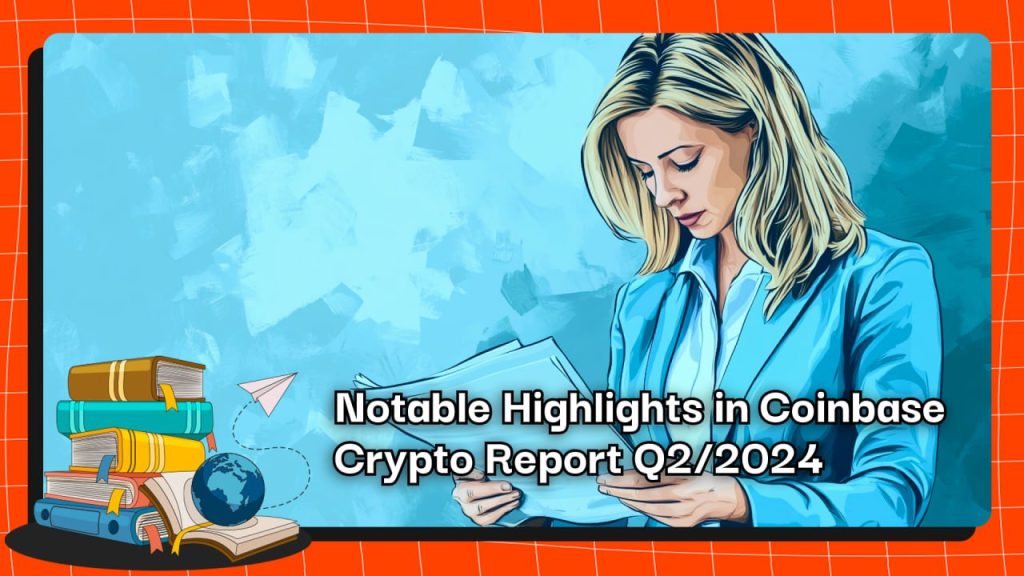The “State of Crypto: Fortune 500 Moving Onchain” report by Coinbase, as of Q2/2024, provides an updated perspective on the adoption of blockchain by the largest companies in the United States. Additionally, the Coinbase crypto report highlights the trends in adopting RWA (Real-World Assets) and stablecoins, two sectors that have seen significant growth recently.

Fortune 500 Ventures into Blockchain and Crypto
Fortune 500 (F500) is a ranking list of the 500 largest companies in the United States, compiled by Fortune magazine based on total revenue achieved in the previous year.
According to the Coinbase crypto report, the number of crypto, blockchain, or Web3 initiatives by F100 companies (the top 100 largest companies in the United States) increased by 39% compared to the same period in 2023, reaching a record high in Q1/2024.
Additionally, survey results from the F500 group indicate that 56% of companies are implementing blockchain-related projects, primarily focusing on payment applications.

Many products, services, and major names in the traditional financial sector (TradFi) are utilizing blockchain and crypto technology. Here are some notable examples:
- First and foremost are the spot Bitcoin ETFs and spot Ethereum ETFs. These ETF products help traditional investors access the crypto market easily, safely, and legally.
- Besides ETFs, RWA products related to government securities are attracting significant investor interest. BlackRock’s tokenized US T-Bill (short-term US government bonds) fund recently surpassed a market cap of $500 million, becoming the largest fund to date.
- By 2030, the RWA market is projected to reach $16 trillion, equivalent to the current GDP of the European Union (EU).
- Stablecoin transaction volume reached approximately $10 trillion in 2023, more than 10 times the amount of global remittances. PayPal and Stripe are companies striving to implement stablecoins in practice. Merchants on Stripe can now accept payments in USDC. Meanwhile, PayPal is facilitating cross-border transfers in over 160 countries through stablecoins.
- Employees of the largest companies and organizations in the United States are also venturing into crypto investments. 68% of respondents believe that crypto addresses the weaknesses of traditional finance in terms of transaction fees and processing time.
Read more: Everyone Is An Analyst: Recommend 7 Free On-chain Data Analysis Tools
Furthermore, changes in the F500’s strategies towards blockchain highlight the growing recognition of this technology’s importance:
- According to F500 financial reports, the average budget allocated for blockchain projects in 2024 is $9.5 million. Most F500 CEOs indicate that their companies will maintain or increase this budget over the next two years.
- The primary motivation for F500 companies to invest in blockchain projects stems from the belief that it is a crucial technology for the future. Additionally, the objectives of these projects align with company strategies, improve efficiency, and create new revenue streams.
- For F500 companies without any plans or initiatives regarding crypto and blockchain, the biggest barriers are the lack of qualified personnel and concerns about regulatory issues.

Crypto and Blockchain are Being Widely Adopted
It can be said that crypto and blockchain are bringing a refreshing change to traditional sectors, particularly finance and technology. In Q1/2024, 80% of crypto and blockchain initiatives by F100 companies belonged to these two sectors.
In Finance
The focus of products and services in this field is none other than Bitcoin ETFs:
- Bank of America, Wells Fargo, and Morgan Stanley are beginning to roll out spot Bitcoin ETF products for their clients.
- Goldman Sachs, JPMorgan, and Citi have become authorized institutions to trade Bitcoin ETFs.
- Moreover, most of the above financial institutions are experimenting with the use of internal tokens.
In Technology
The potential of blockchain is being increasingly explored and utilized by leading tech companies:
- Google has announced and implemented new features that allow users to search for blockchain information directly on its search engine.
- Google is also supporting infrastructure by becoming a validator for several new blockchain platforms like Celo Network, Theta Network, and Solana.
- Microsoft has participated in the trial of Canton Network, a new blockchain designed optimally for RWA.
- IBM is collaborating with Casper Labs to apply blockchain in data verification and training AI models.
In Other Sectors
Apart from finance and technology, crypto and blockchain are also being applied in various other fields such as retail, healthcare, consumer goods, etc. For example:
- Using crypto as a form of cross-border payment, retailers can easily reach customers in remote, underprivileged areas.
- Applying token economies for Web3 gaming, creating a novel and attractive P2E (Play to Earn) mechanism compared to traditional games.
- Doctors, patients, and family members can manage and track encrypted health data on the Blockchain.
- Non-profit organizations receive charitable donations in crypto.
- Celebrities release NFTs for their fans.
- Artworks are encoded as NFTs to eliminate copyright infringement.
The Most Notable Highlight: RWA
RWA, encompassing both stablecoin and non-stablecoin categories, has shown remarkable development recently.
Stablecoin
Stablecoins have garnered significant attention due to their ability to optimize transaction speed and costs.
According to the Coinbase crypto report, 70% of CEOs from F100 companies expressed interest in exploring and using stablecoins to improve payment processes. Additionally, 86% of F500 companies have recognized the potential benefits of stablecoins, with 35% of them currently planning stablecoin-related projects.
Notably, despite the lack of clear legal regulations for stablecoins, this particular asset is still widely used.
The following statistics illustrate the recent boom in stablecoins:
- Daily stablecoin transfer volumes have been steadily increasing since Q3/2023, reaching an all-time high (ATH) of $100 billion in Q1/2024.
- The annual trading volume of stablecoins reached $10 trillion in 2023, more than 10 times the amount of global remittances.
- Mentions of stablecoins in SEC filings have been on the rise, peaking in early 2024.
- As of Q2/2024, issuers of USDC (Circle) and USDT (Tether) hold US T-Bills (to back USDC and USDT) in amounts comparable to those of Norway, Saudi Arabia, and South Korea.

Non-stablecoin
Other RWAs that are not stablecoins (non-stablecoin RWAs) have also made significant strides in the first half of 2024. This is evidenced by the following data:
- The total value of non-stablecoin RWAs reached approximately $3 billion, more than doubling since early 2023. This statistic includes only publicly trackable assets, so the actual number is much higher.
- With high safety and yields, government securities are accelerating the tokenization of real assets. US T-Bills are the only assets chosen for tokenization by BlackRock and Franklin Templeton, with their market cap increasing over 1000% since January 2023, reaching $1.29 billion as of May 31, 2024.
- Gold is the only commodity that has been tokenized, with a value of about $1 billion.
- The total value of tokenized private debt has increased from nearly zero in October 2020 to over $400 million in April 2024.

BlackRock, the world’s largest asset manager, made headlines by launching its first tokenized real asset fund, named BUIDL.
BUIDL was deployed on the Ethereum network and officially launched on March 20, 2024. Partnering with renowned digital asset securities firm Securitize, BlackRock’s BUIDL fund offers investors the opportunity to earn attractive yields from US T-Bills.
Early participants in the BUIDL ecosystem include leading names in the crypto space, such as Anchorage Digital Bank NA, BitGo, Coinbase, and Fireblocks.
BUIDL has grown rapidly since March 2024, surpassing Franklin Templeton’s FOBXX fund, which had been the top fund for many years. BUIDL now leads the tokenized US T-Bill market with nearly 30% market share. Companies following closely behind are Ondo Finance and Superstate.

Read more: Best Real World Assets Tokens To Watch in 2024!
Actions Needed to Promote Crypto and Blockchain Adoption
In the Coinbase crypto report, the exchange has made several recommendations specifically for the United States to promote the adoption of crypto and blockchain in traditional sectors:
- The United States needs to nurture talent instead of continuing to lose them to other countries. Statistics show that only about 26% of blockchain developers are working in the U.S. This is also a concern for CEOs of F500 companies, who admit they are struggling to recruit qualified personnel in this area.
- Clear legal regulations for crypto and blockchain are needed, as this is key to retaining developers and continuing to keep the U.S. at the forefront of technological innovation.
- About 48% of F500 CEOs believe that crypto increases access to any financial and banking system. Therefore, to scale quickly and expand their user base, traditional companies need to adopt crypto/blockchain as soon as possible.
- Finally, the U.S. needs to leverage its leadership role in this field. 79% of F500 company CEOs want to implement crypto and blockchain projects in the U.S. Additionally, 72% agree that having a USD-backed digital currency would enhance the U.S.’s economic competitiveness globally.
Conclusion
Through the Coinbase crypto report, we see how prevalent and widely adopted blockchain and crypto technologies have become in various sectors of life. Financial products such as Bitcoin ETFs, US T-Bills, and other blockchain applications reflect the significant transformation of the world through technological advancements.
Overall, this Coinbase crypto report not only provides a comprehensive view of current trends but also calls for maximizing the potential of blockchain and crypto to move towards a comprehensive digital future.
| DISCLAIMER: The information on this website is provided as general market commentary and does not constitute investment advice. We encourage you to do your own research before investing. |























